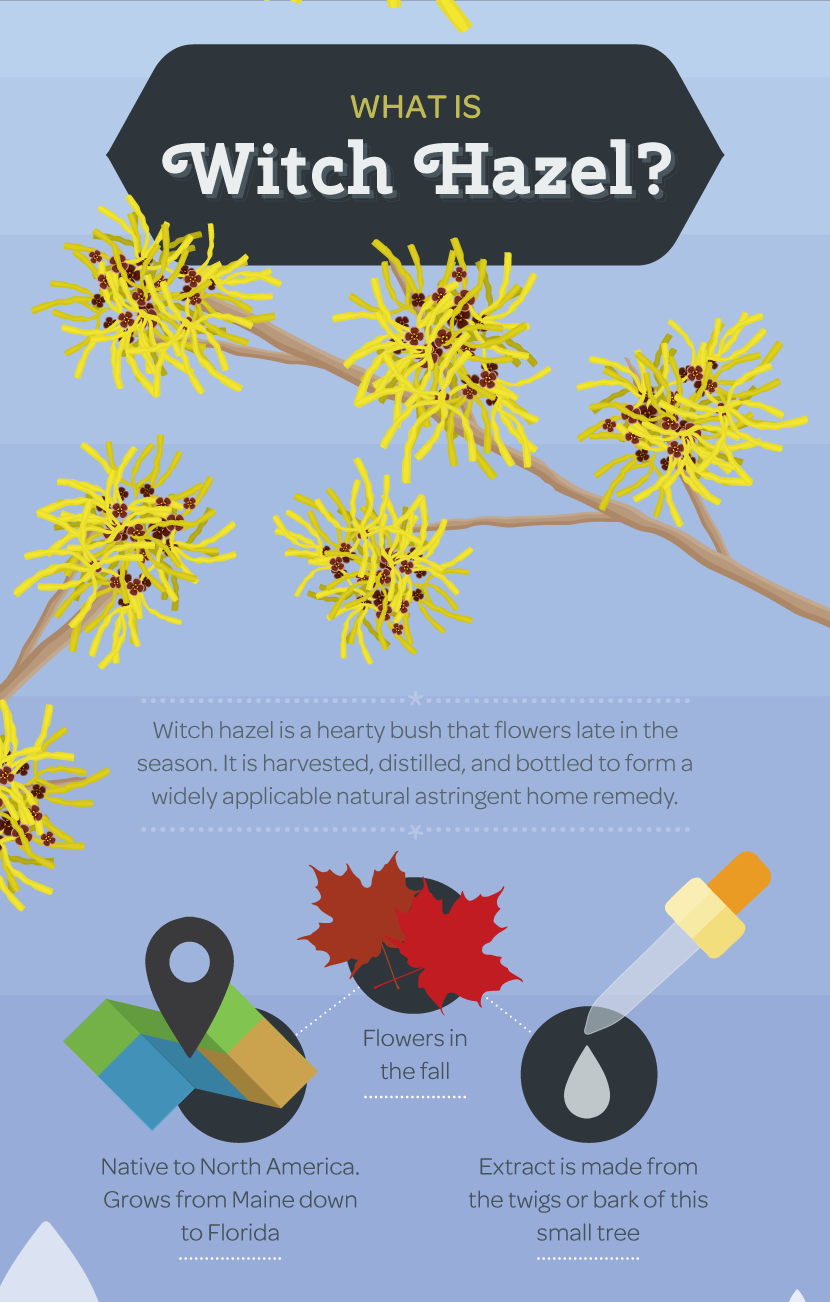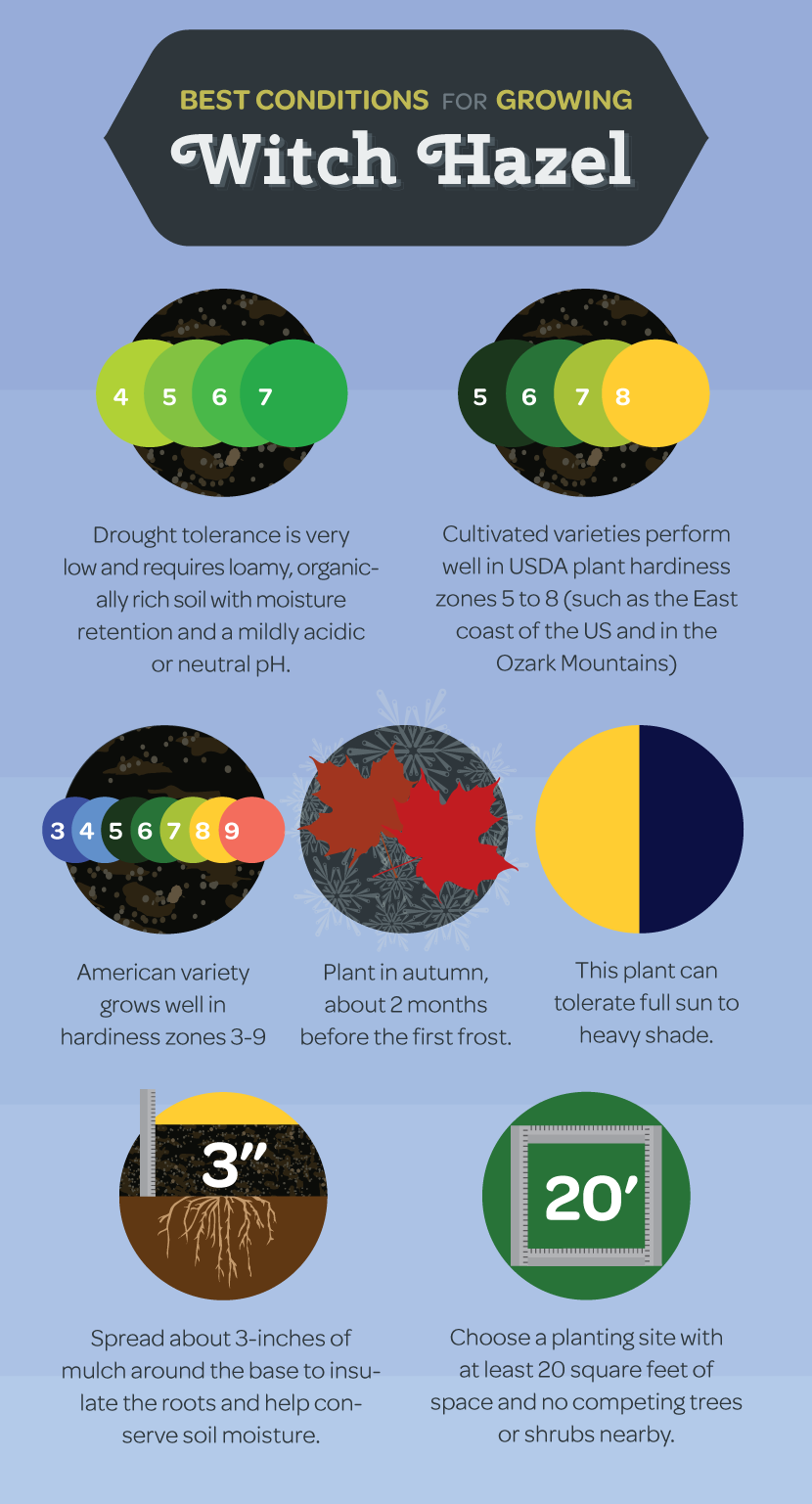Don’t be Spooked by Witch Hazel:
Amazing Uses and Benefits
Practically a panacea, witch hazel has dozens of uses from bug spray to skin toner. It is most widely acclaimed for its astringent qualities, mostly due to the tannins and flavonoids contained inside the tender bark and leaves of the plant.https://www.theatlantic.com/health/archive/2012/11/the-mysterious-past-and-present-of-witch-hazel/264553/ Early use included the application of witch hazel on cuts and bruises, and as a tea for colds and coughs.
Early adopters administered witch hazel by applying the bark directly, burning twigs in a fire to create an essential oil-rich steam, and brewing tea. Now, witch hazel, one of the few plants given a thumbs-up by the FDA (Food and Drug Administration), is included in tinctures and tonics across drugstore shelves everywhere.
But what is witch hazel? Considering the degree of its power, it is rather unassuming in appearance. Witch hazel, or Hamamelis virginiana, is a small shrub with small yellow flowers that bloom in late fall or winter. There are often several stems at the base of the bush, and it typically reaches 10–15 inches (25–38 cm) in height.http://homeguides.sfgate.com/conditions-witch-hazel-plant-90130.html The name Hamamelis means “together with fruit,” which references an unusual characteristic of the plant flowers appearing simultaneously with the fruit.

There are several folk names for witch hazel. “Snapping hazel” refers to the popping sound the dry fruit of the bush can make when they ripen.http://www.witchipedia.com/herb:witch-hazel Other names for witch hazel include “spotted alder” and “winter bloom,” because of the late-season bloom of its yellow flowers. Interestingly, witch hazel often blooms after the plant has already dropped its leaves.
Witch hazel grows most prolifically in areas such as Connecticut, Maine, and New Hampshire. In the business of commercializing witch hazel, it makes sense that the biggest business started in these areas.
Historically, there are many applications for witch hazel. Witch hazel even has a place in the Wiccan community as a banisher of disease and negative emotions.
Witch hazel is also used in “dowsing.” Dowsing is the practice of taking a forked branch of the witch hazel bush and walking with it in search of subterranean water. When water lies below, the branch reportedly bends toward the ground.

But what benefits of witch hazel are steeped in science? Not a ton, unfortunately, which is true for many natural remedies. What we do know is that witch hazel contains properties that have been shown to have efficacy in studies non-specific to witch hazel. Tannins, flavonoids, and essential oils are the three main medicinally active properties of the witch hazel plant. Tannins are also present in foods such as red wine, chocolate, and tea. These tannins, although sometimes difficult to digest, are widely accepted to reduce inflammation and conquer free radicals with their antioxidant benefit.http://www.thedermreview.com/witch-hazel/ Tannins also have an antibacterial component, which may be why witch hazel is considered to be so effective for acne and disinfecting abrasions. The second potent ingredient in witch hazel is flavonoids. Flavonoids are a group of chemicals widely understood to confer antioxidant and anti-inflammatory benefit.https://www.ncbi.nlm.nih.gov/pubmed/15678717
Euell Gibbons, leader in the concept of natural living during the ‘60s and ‘70s, called witch hazel “the epitome of herbal remedy.” To this point, there appear to be dozens of uses for this hearty bush, but the uses most grounded in science are as a topical astringent for abrasions or cuts, and as a toner for acne.http://www.berkeleywellness.com/self-care/home-remedies/article/witch-hazel-which-claims-are-true Other applications that are mentioned, but less documented, in studies are for the treatment of hemorrhoids, stretch marks, diaper rash, dandruff, varicose veins, rashes, bruising, and razor burn.https://wellnessmama.com/60603/uses-for-witch-hazel/

Based on the many possible benefits, it seems that witch hazel might be an excellent addition to your back yard. It is hearty and a wonderful pollinator, and is easily harvested. The plant thrives best in hardiness zones 5–8, but some species of witch hazel are not so zone-choosey. Full sun is best for witch hazel if you wish to cultivate it. A sunny spot will give rise to a more compact, fuller bush, but witch hazel will do just fine in shade. Avoid planting witch hazel in soils with poor drainage. Although hearty, the roots like to have plenty of space, so make sure that the root system will be undisturbed by other plantings close by.

Want to make your own witch hazel tincture? Easy. Follow this recipe for making your own witch hazel remedy, adapted from Handmaiden's Kitchen:
- Prune one pound (about half a kilogram) of fresh twigs as soon as they have flowered to produce the strongest tonic.
- Strip off the leaves and flowers and chop the twigs into a coarse mulch. You can either use a mechanical mulcher or pruning clippers.
- Place the chopped twigs into a stainless steel pot that holds at least 2 gallons.
- Cover the twigs with distilled water and bring the contents to a boil.
- Reduce heat and simmer for at least eight hours; adding water as needed so the mulch remains covered.
- Allow the mixture to cool to room temperature.
- Pour the witch hazel tonic through a cheesecloth-lined funnel and into clean plastic squeeze bottles or other tightly-capped containers.
- For best results, use the tonic within a week of preparation, and be sure to keep it refrigerated. For long-term storage at room temperature, you can preserve your tonic by adding nine ounces (250 g) of vodka or grain alcohol to 23 ounces (650 g) of tonic (yield: one gallon).
- Do not use internally and keep away from children.
A simple DIY method is to make your own pre-treated witch hazel pads. Use a four-ounce (110 g) Mason jar. Inside, place a stack of heavy-duty round cotton pads. Cover the pads with either store-bought witch hazel or your home remedy and you have ready-to-use face toner, abrasion treatment, and deodorant.
Witch hazel has been cultivated and used medicinally for hundreds of years. Its use across cultures and generations lends credibility to the claims of its many benefits. Safe and non-invasive, witch hazel is an excellent choice for any household’s go-to wellness options.
Embed the article on your site

